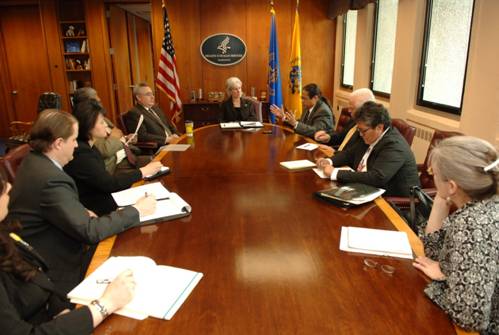IEA Tribal Affairs
Purpose
The Tribal Affairs component of the Office of Intergovernmental and External Affairs was established in 2000 to serve as the official first point of contact for Tribes, Tribal Governments, and Tribal Organizations wishing to access the Department of Health and Human Services (HHS). Organizationally, the Tribal Affairs component is situated within the Immediate Office of the Secretary, Office of Intergovernmental and External Affairs (IEA) and is the Departments’ lead office for Tribal Consultation in accordance with Executive Order 13175- Consultation and Coordination with Indian Tribal Governments. Other duties and responsibilities of the Office of Tribal Affairs include:
- Coordination and management of IGA's tribal and native policy issues and serves as the Department's expert and informational resource to the Secretary
- Provides executive direction for the Secretary's Intradepartmental Council on Native American Affairs (ICNAA)
- Collaboration and outreach to Tribes and national Native organizations
- Coordination of HHS participation in national Tribal meetings and Tribal site visits for HHS executive leadership
- Advice and assistance to the HHS Regional Directors and Senior staff on tribal affairs
- Coordination of the Secretary's policy development for Tribes and national Native organizations
2010 Major Accomplishments
In 2010, HHS has had several major accomplishments at the national, regional and tribal levels that are pertinent to American Indian Tribes and Alaskan Native Villages. Examples include national reform such as the permanent reauthorization of the Indian Health Care Improvement Act; regional activities such as the HHS Regional Consultations, and tribal events such as the Tribal Leaders Roundtable.
Read about HHS 2010 major accomplishments.
Tribal Consultation Policy
The U. S. Department of Health and Human Services (HHS) and Indian Tribes share the goal to establish clear policies to further the government-to-government relationship between the Federal Government and Indian Tribes. True and effective consultation shall result in information exchange, mutual understanding, and informed decision-making on behalf of the Tribal governments involved and the Federal Government. The importance of consultation with Indian Tribes was affirmed through Presidential Memoranda in 1994, 2004 and 2009, and an Executive Order (EO) in 2000.
The goal of this policy includes, but is not limited to, eliminating health and human service disparities of Indians, ensuring that access to critical health and human services is maximized, and to advance or enhance the social, physical, and economic status of Indians. To achieve this goal, and to the extent practicable and permitted by law, it is essential that Federally-recognized Indian Tribes and the HHS engage in open, continuous, and meaningful consultation.
This policy applies to all Divisions of the Department and shall serve as a guide for Tribes to participate in all Department and Division policy development to the greatest extent practicable and permitted by law. Read more.
Secretary’s Tribal Advisory Committee (S.T.A.C)
The Secretary’s Tribal Advisory Committee signals a new level of attention to Government-to-Government relationship between HHS and Indian Tribal Governments.
The STAC’s primary purpose is to seek consensus, exchange views, share information, provide advice and/or recommendations; or facilitate any other interaction related to intergovernmental responsibilities or administration of HHS programs, including those that arise explicitly or implicitly under statute, regulation or Executive Order. This purpose will be accomplished through forums, meetings and conversations between Federal officials and elected Tribal leaders in their official capacity (or their designated employees or national associations with authority to act on their behalf). Read more.
ICNAA
The Intradepartmental Council on Native American Affairs (ICNAA), authorized by the Native American Programs Act of 1974 (42USC2991), as amended, serves as the focal point within the Department of Health and Human Services (HHS) for coordination and consultation on health and human services issues affecting the American Indian, Alaska Native and Native American (AI/AN/NA) population, which includes more than 560 federally recognized tribes, approximately 60 tribes that are state recognized or seeking federal recognition, Indian organizations, Native Hawaiian communities, and Native American Pacific Islanders, including Native Samoans. Read more.
Tribal Resources
HHS provides a vast amount of resources for Tribes. Below includes a list of resources that may be helpful.
Dept. of Health and Human Services Grant Information
Healthcare Reform & the Affordable Care Act information
Roundtable discussion between Tribal Leaders and Secretary Sebelius on March 2, 2010, in Washington, D.C.

Left to Right: Paul Dioguardi, Director, Intergovernmental Affairs; Yvette Roubideaux, Director, Indian Health Service; Ned Norris, Chairman, Tohono O’odham Nation; Jefferson Keel, President, National Congress of the American Indians; HHS Secretary Kathleen Sebelius; Mark Macarro, President, Pechanga Tribe; Buford Rolin, Vice Chairman, National Indian Health Board; Theresa Two Bulls, President, Oglala Sioux Tribe; and Laura Petrou, Chief of Staff, Office of Secretary Kathleen Sebelius.





